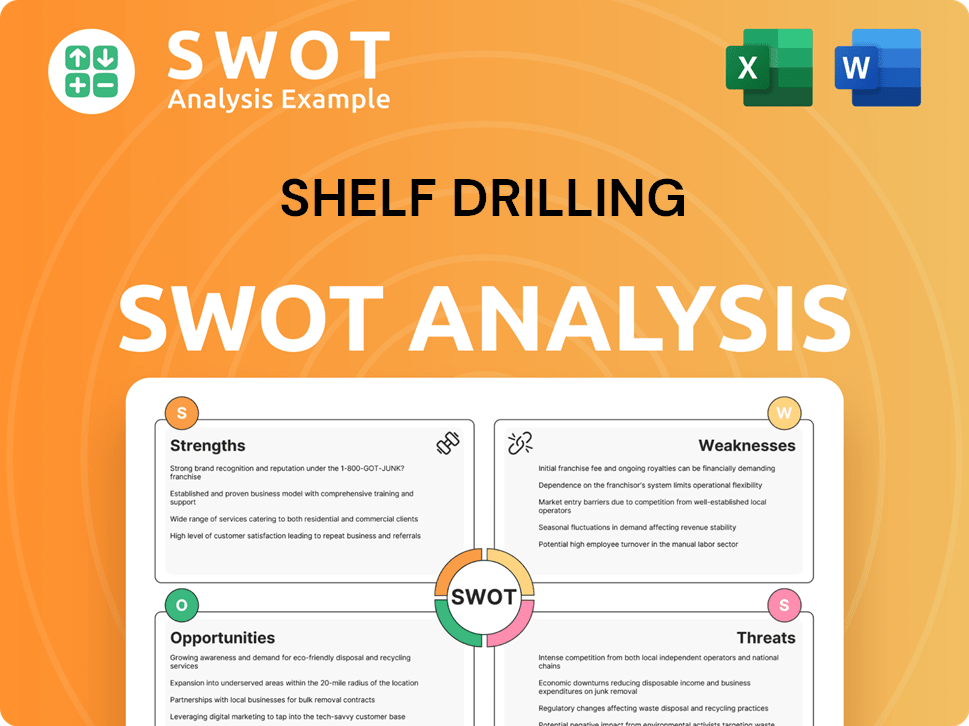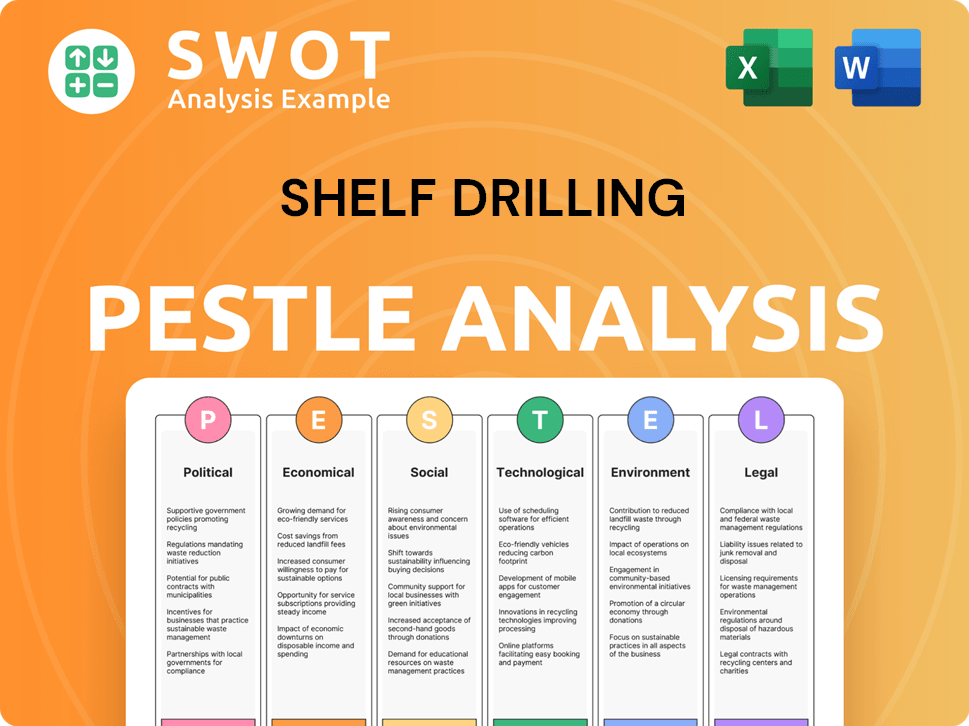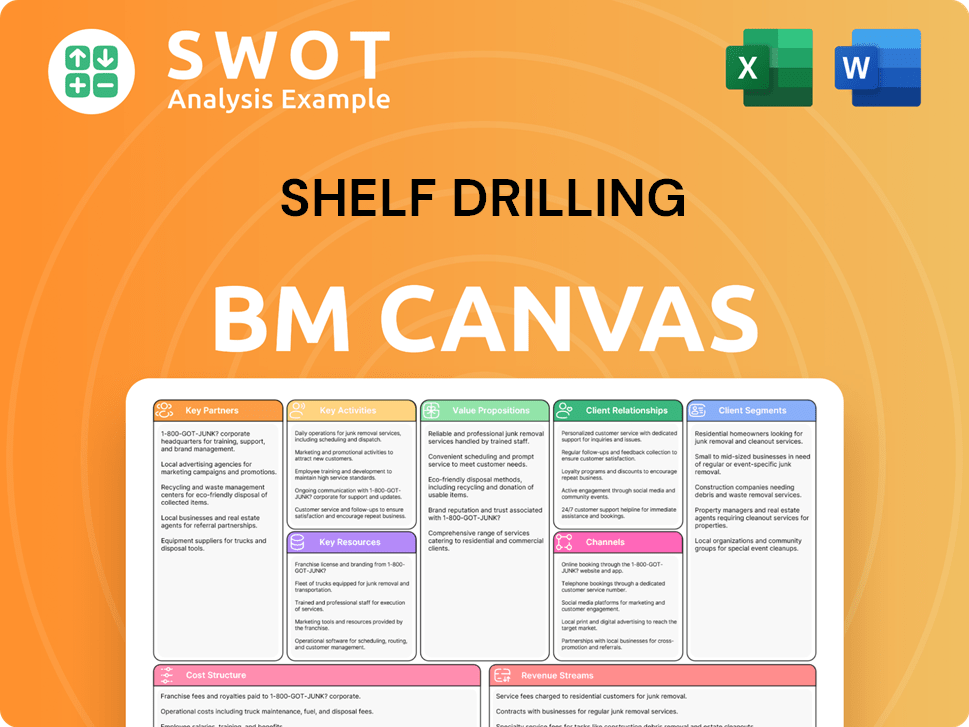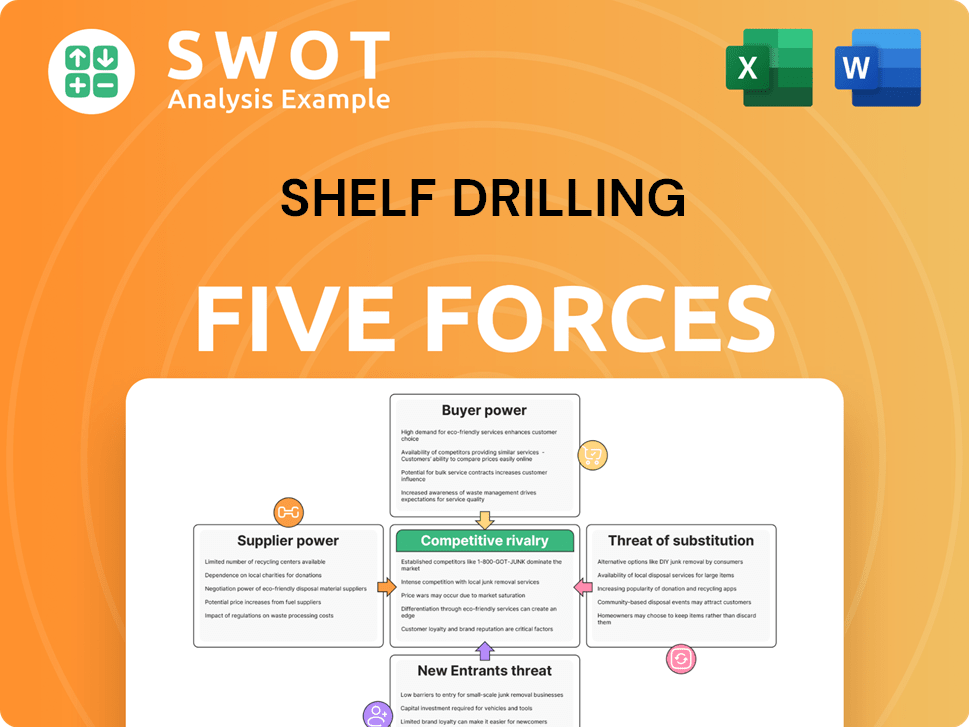Shelf Drilling Bundle
Who Really Owns Shelf Drilling?
Understanding the ownership structure of a company is crucial for investors and stakeholders alike. The evolution of ownership can reveal a company's strategic shifts and its commitment to various stakeholders. Shelf Drilling, a key player in the offshore drilling sector, presents a compelling case study in this regard. This article will explore the intricacies of Shelf Drilling SWOT Analysis, its ownership, and the implications for its future.

This exploration of Shelf Drilling ownership will examine the key players, from institutional investors to private equity firms, shaping the company's destiny. We'll analyze the composition of the Board of Directors and the distribution of voting power, all while considering recent developments in the oil and gas industry. Whether you're interested in Shelf Drilling company or the drilling rigs it operates, this analysis provides a comprehensive overview.
Who Founded Shelf Drilling?
The story of Shelf Drilling begins in November 2012. That's when Shelf Drilling Holdings Limited was created as a private entity. The company's initial focus was acquiring a fleet of jack-up rigs from Transocean Ltd.
The early days saw Shelf Drilling working closely with Transocean. A transition services agreement was in place to help with the handover. Key members of the management team, including David Mullen, came from Transocean's senior leadership.
The foundation of Shelf Drilling's ownership was heavily influenced by private equity firms. These firms provided the financial backing needed to launch the company and acquire its initial assets.
The primary private equity investors at Shelf Drilling's inception included Castle Harlan, CHAMP Private Equity, and Lime Rock Partners. These firms brought a wealth of experience in the oil and gas industry and a global reach.
- Castle Harlan, established in 1987, has managed approximately $6 billion in capital commitments across eight private equity funds.
- CHAMP Private Equity, also founded in 1987, has overseen ten private equity funds with over $4 billion in total capital commitments.
- Lime Rock Partners, founded in 1998, manages nearly $5 billion of private capital, focusing on energy industry investments.
Shelf Drilling SWOT Analysis
- Complete SWOT Breakdown
- Fully Customizable
- Editable in Excel & Word
- Professional Formatting
- Investor-Ready Format

How Has Shelf Drilling’s Ownership Changed Over Time?
The ownership structure of Shelf Drilling has seen significant changes since its initial public offering (IPO) on the Oslo Stock Exchange in 2018. Initially a private company, its transition to a publicly listed entity marked a crucial step in its corporate journey. Further evolution occurred with the listing of Shelf Drilling (North Sea), Ltd. (SDNS) on the Euronext Growth Oslo Exchange in October 2022, where Shelf Drilling Holdings, Ltd. held a 60% stake.
A pivotal moment in Shelf Drilling's ownership history was the acquisition of the remaining 40% stake in SDNS in October 2024. This transaction made SDNS a wholly-owned subsidiary of Shelf Drilling, involving both cash and equity, and the issuance of new common shares. These strategic moves highlight the company's efforts to consolidate its operations and adapt to the dynamic offshore drilling market. For more details on the company's operations, you can read about the Revenue Streams & Business Model of Shelf Drilling.
| Date | Event | Impact on Ownership |
|---|---|---|
| 2018 | Initial Public Offering (IPO) | Shelf Drilling became a publicly listed company. |
| October 2022 | SDNS Listing on Euronext Growth Oslo | Introduction of external investors in SDNS. |
| October 2024 | Acquisition of SDNS's remaining stake | SDNS became a wholly-owned subsidiary of Shelf Drilling. |
As of early 2025, Shelf Drilling's ownership is diverse, with institutional investors holding approximately 19.2% of the shares. Individual insiders own about 1.48%, while private companies hold 5.27%. Venture capital and private equity firms have a 7.9% stake, and hedge funds own 8.38%. The general public, including retail investors, holds the largest portion at 57.8%. Key shareholders include Caius Capital LLP (10.0% as of January 2025), Condire Investors, LLC (8.5%), and Castle Harlan, Inc. (8.0%). China Merchants Group Limited held a 10.47% stake as of October 2024. These ownership dynamics reflect the ongoing investment interest in the offshore drilling sector.
Shelf Drilling transitioned from private to public ownership, with significant institutional and retail investor participation.
- The acquisition of SDNS in 2024 consolidated its structure.
- Major shareholders include institutional investors and private equity firms.
- Ownership structure reflects the evolving dynamics of the offshore drilling industry.
- The general public holds the largest share of the company.
Shelf Drilling PESTLE Analysis
- Covers All 6 PESTLE Categories
- No Research Needed – Save Hours of Work
- Built by Experts, Trusted by Consultants
- Instant Download, Ready to Use
- 100% Editable, Fully Customizable

Who Sits on Shelf Drilling’s Board?
The Board of Directors at Shelf Drilling, Ltd. oversees the company's governance and strategic direction. As of May 2025, the company operates with a 'one-share-one-vote' structure, where each of the 256,390,799 common shares issued represents one vote, ensuring equal voting rights for all shareholders. This structure promotes a fair distribution of voting power among the shareholders of the Shelf Drilling company.
While specific details on board member representation, such as major shareholders or independent seats, aren't fully available in public records, it's known that private equity firms have significant influence. For example, Castle Harlan, Inc. holds approximately 8.0% of the company's stock, which can impact board decisions. This information is crucial for understanding the Shelf Drilling ownership structure and the dynamics within the offshore drilling sector.
| Board Governance Changes | Details | Impact |
|---|---|---|
| Removal of Special Rights | Provisions granting a Principal Shareholder special rights to appoint Directors and observers were removed, approved in December 2024. | Aimed to democratize board appointments. |
| Remuneration Guidelines | The Board of Directors must establish transparent guidelines for CEO, key executives, and Director compensation, subject to shareholder approval. | Increased transparency and shareholder involvement. |
| Remuneration Report | An annual 'Remuneration Report' will be subject to a non-binding advisory vote by shareholders. | Enhances shareholder oversight of executive pay. |
| Meeting Minutes | Minutes from general meetings are now publicly accessible on the company's website. | Promotes transparency and access to corporate information. |
Recent changes in governance practices at Shelf Drilling, as detailed in Growth Strategy of Shelf Drilling, reflect a commitment to greater transparency and shareholder engagement. These include removing special appointment rights for major shareholders and implementing detailed guidelines for executive compensation, which must be approved by shareholders. The accessibility of meeting minutes further enhances transparency, providing shareholders with more insight into the company's operations and decisions. These changes are designed to improve the governance of the Shelf Drilling company and align the interests of the board with those of its shareholders.
Shelf Drilling has implemented several key governance changes to increase transparency and shareholder involvement.
- Removal of special appointment rights for major shareholders.
- Implementation of transparent compensation guidelines subject to shareholder approval.
- Public accessibility of general meeting minutes.
- These changes are designed to improve the governance of the Shelf Drilling company.
Shelf Drilling Business Model Canvas
- Complete 9-Block Business Model Canvas
- Effortlessly Communicate Your Business Strategy
- Investor-Ready BMC Format
- 100% Editable and Customizable
- Clear and Structured Layout

What Recent Changes Have Shaped Shelf Drilling’s Ownership Landscape?
Over the last few years, several developments have significantly impacted the ownership profile and strategic direction of Shelf Drilling. A key move was the complete acquisition of Shelf Drilling (North Sea) Ltd. in October 2024, where Shelf Drilling acquired the remaining 40% stake. This consolidation was part of Shelf Drilling's strategy to optimize its fleet and adapt its investment approach to market conditions.
Industry trends show increased institutional ownership within Shelf Drilling's shareholder base. The company has also been managing the effects of Saudi Aramco's decision to decrease offshore capital spending in 2024, which led to the suspension of seven out of nine Shelf Drilling rigs operating in Saudi Arabia by the end of that year. This prompted the company to seek redeployment opportunities for its rigs in regions like West Africa and Southeast Asia, where demand is growing despite high competition. In January 2025, Shelf Drilling sold the Main Pass I rig for $11 million for non-drilling applications. The company also announced a strategic alliance with Arabian Drilling in February 2025 to expand its international offshore drilling reach.
| Key Development | Date | Details |
|---|---|---|
| Acquisition of Shelf Drilling (North Sea) Ltd. | October 2024 | Acquired remaining 40% stake |
| Sale of Main Pass I rig | January 2025 | Sold for $11 million |
| Strategic Alliance with Arabian Drilling | February 2025 | Expansion of international reach |
Looking ahead, Shelf Drilling continues to assess market dynamics and explore opportunities for fleet transformation through cost-effective transactions. The company anticipates generating significant free cash flow in the coming years. For more insights into the company's target market, you can read this article about the Target Market of Shelf Drilling.
The sale of the Main Pass I rig in January 2025 for $11 million and the strategic alliance with Arabian Drilling in February 2025 are recent developments. These moves reflect Shelf Drilling's efforts to adapt to market conditions and expand its operational reach. The company is actively seeking to optimize its fleet and explore new opportunities.
Shelf Drilling is experiencing shifts in its ownership structure, with a notable presence of institutional investors. The company is also navigating the impacts of changes in the offshore drilling market. These trends suggest a focus on strategic consolidation and adapting to industry dynamics.
Shelf Drilling is focused on fleet optimization through cost-effective transactions. This includes selling assets and seeking redeployment opportunities for its rigs. The company is also exploring strategic alliances to enhance its operational capabilities and market presence in the oil and gas industry.
The company anticipates generating significant free cash flow in the coming years. This financial outlook is supported by strategic initiatives, including fleet optimization and expansion of its global reach. The focus remains on enhancing financial performance and adapting to the offshore drilling market.
Shelf Drilling Porter's Five Forces Analysis
- Covers All 5 Competitive Forces in Detail
- Structured for Consultants, Students, and Founders
- 100% Editable in Microsoft Word & Excel
- Instant Digital Download – Use Immediately
- Compatible with Mac & PC – Fully Unlocked

Related Blogs
- What are Mission Vision & Core Values of Shelf Drilling Company?
- What is Competitive Landscape of Shelf Drilling Company?
- What is Growth Strategy and Future Prospects of Shelf Drilling Company?
- How Does Shelf Drilling Company Work?
- What is Sales and Marketing Strategy of Shelf Drilling Company?
- What is Brief History of Shelf Drilling Company?
- What is Customer Demographics and Target Market of Shelf Drilling Company?
Disclaimer
All information, articles, and product details provided on this website are for general informational and educational purposes only. We do not claim any ownership over, nor do we intend to infringe upon, any trademarks, copyrights, logos, brand names, or other intellectual property mentioned or depicted on this site. Such intellectual property remains the property of its respective owners, and any references here are made solely for identification or informational purposes, without implying any affiliation, endorsement, or partnership.
We make no representations or warranties, express or implied, regarding the accuracy, completeness, or suitability of any content or products presented. Nothing on this website should be construed as legal, tax, investment, financial, medical, or other professional advice. In addition, no part of this site—including articles or product references—constitutes a solicitation, recommendation, endorsement, advertisement, or offer to buy or sell any securities, franchises, or other financial instruments, particularly in jurisdictions where such activity would be unlawful.
All content is of a general nature and may not address the specific circumstances of any individual or entity. It is not a substitute for professional advice or services. Any actions you take based on the information provided here are strictly at your own risk. You accept full responsibility for any decisions or outcomes arising from your use of this website and agree to release us from any liability in connection with your use of, or reliance upon, the content or products found herein.